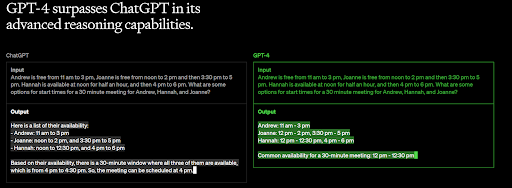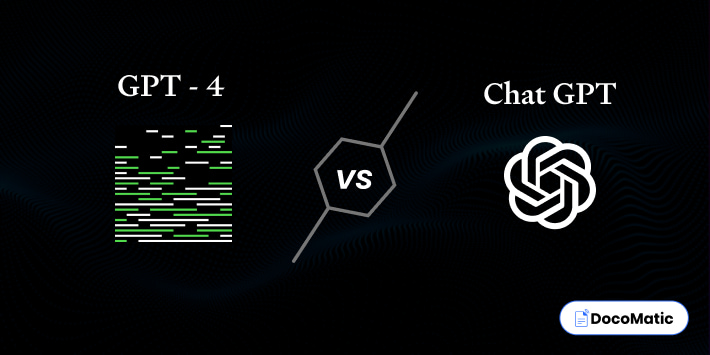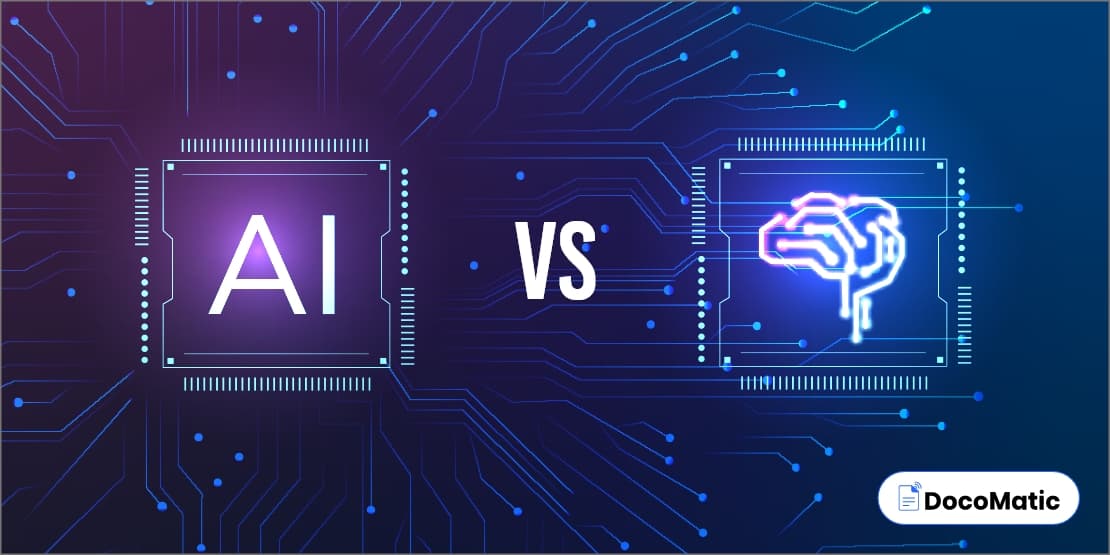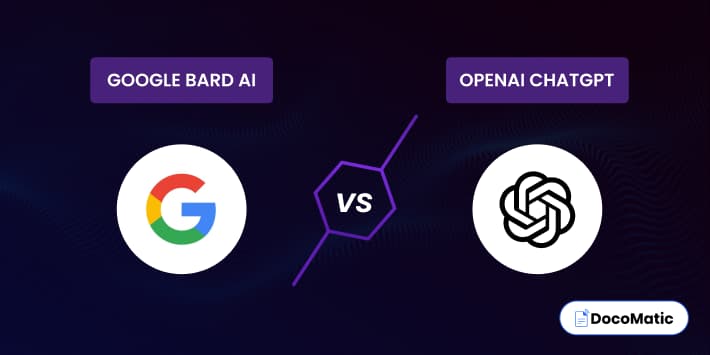Key Takeaways:
1. GPT-4 and ChatGPT are both powerful language models with different focuses.
2. GPT-4 may have a larger parameter size and improved training methods.
3. ChatGPT excels in conversational AI and can be fine-tuned for specific tasks.
4. Choosing between GPT-4 and ChatGPT depends on the specific use case and requirements.
With the release of GPT-4 (the latest generative pre-trained transformer model), OpenAI has once again made headlines in the tech world. GPT-4 is the much-awaited follow-up to their stunning hit, ChatGPT.
Many questioned how OpenAI could surpass the success of ChatGPT, which was propelled by the outstanding GPT-3.5 language model. But, OpenAI has provided a model (GPT-4) that is much bigger and better than its predecessor, albeit they haven’t yet said by how much. However, they have made a demo video that gives us a glimpse of what to anticipate from this new technology.
So, what makes GPT-4 so unique? What distinguishes it from ChatGPT and GPT-3.5, its predecessors? All these questions will be addressed in this blog post.
Here is a detailed comparison guide in between GPT-4 vs ChatGPT, fascinating new features and abilities of GPT-4, which have already created a lot of buzz in the tech world, and answer these questions in further detail.
Prepare to learn more about language modeling technology’s future as we compare GPT-4 vs ChatGPT.
Table of Content
- GPT-4 Outperforms ChatGPT in Creativity
- More Than Just Text: Image Recognition
- GPT-4: Harder to Trick and More Stable Than Its Predecessor
- GPT-4’s Expanded Memory: Keeping Up to 50 Pages in Mind
- GPT-4 Processes More Words and Delivers Precise Responses
- GPT-4 is Breaking Language Barriers with its Multilingual Capabilities
- GPT-4: The Safer Chatbot with Enhanced Monitoring and Filtering Capabilities
- Human-Level Performance on Professional and Academic Tests
- FAQs
- Beyond GPT-3: GPT-4 is Changing the Landscape of AI
1. GPT-4 Outperforms ChatGPT in Creativity
The GPT-4 model from OpenAI outperforms ChatGPT, an AI chatbot powered by GPT-3.5 in terms of performance while introducing a new degree of creativity. While both models are capable of coming up with creative answers to questions, GPT-4 has advanced this capability.
GPT-4 excels at solving complicated problems that call for greater levels of creativity.
For instance, GPT-4’s response would smoothly utilize both English and French on every line of the poem when given the task, but GPT-3.5 would alternate between the two languages, with each line utilizing just one language.
This improvement in creativity opens up some new application possibilities for the model, allowing it to function better across a variety of industries, including marketing, content creation, and creative writing.
2. More Than Just Text: Image Recognition
The capacity of GPT-4 to process and comprehend image input is one of its most substantial improvements. GPT-4 is multimodal, which means it can comprehend many forms of data, such as words and images, in contrast to its predecessor, GPT-3.5, which was restricted to text inputs and responses.
The use cases for GPT-4 now have interesting new options because of this additional capability.
Users of GPT-4 can use it to assist others who have visual problems by asking it to describe what’s happening in a picture.
OpenAI showed GPT-4 describing a clothing design, demonstrating how to use gym equipment, and reading a map.
Moreover, GPT-4’s image interpretation goes beyond recognizing objects in images. Also, it has the ability to examine an image’s content and offer relevant information.
For example, the New York Times asked GPT-4 to come up with an idea for preparing a meal using the ingredients in a picture of a refrigerator’s interior. Another stunning demonstration by OpenAI demonstrated how GPT-4 could quickly transform a sketch into a completely working website.
GPT-4 is a more flexible and potent language model since it can operate with images, opening up new use cases that were previously not viable with GPT-3.5.
Here is a demonstration of OpenAI on how creative GPT-4 is:

Source: OpenAI
3. GPT-4: Harder to Trick and More Stable Than Its Predecessor
Compared to GPT-3, GPT-4 is expected to be more stable and less prone to manipulation.
Presently, one of the biggest problems with chatbots is their propensity to be duped easily. But, over the past year or so, users have helpfully offered OpenAI a large number of malicious prompts. GPT-4 has been trained on the basis of this human feedback. Factuality, steerability, and keeping inside the guardrails are all claimed to be significantly better in the new model than they were in the older one.
GPT-3.5, which ran ChatGPT, is referred to by OpenAI as a “test run” of a new training architecture. This led to the application of the lessons learned by GPT-4, producing an incredibly stable version.

Source: OpenAI
In the above demonstration, the same question was asked in both GPT-4 and ChatGPT. While both AI systems were able to provide a solution, GPT-4’s answer was more precise and short, indicating that it will provide more accurate responses than its predecessor.
GPT-4 is anticipated to be significantly more difficult to trick than GPT-3 because of its capacity to recognize malicious prompts, providing users with more trustworthy results.
4. GPT-4’s Expanded Memory: Keeping Up to 50 Pages in Mind
The capacity of the large language model, such as GPT-3.5, to retain information during conversations was one of its drawbacks. It was limited to retaining 4,096 “tokens,” or around 8,000 words, or four to five pages of a book. After that, the model would fail to remember earlier conversations.
Nevertheless, this issue has been solved with the current GPT-4 model. It now has a maximum token count of 32,768; which is equal to 64,000 words or 50 pages of text. As a result, GPT-4 can now remember information from up to 50 pages while conversing or writing. Hence, even after 20 pages have passed since your discussion, the GPT-4 would still remember everything you discussed.
The new capabilities of GPT-4 are greatly affected by this extended memory. It can yield more consistent and organized information, more relevant and clear responses, and more accurate predictions.
5. GPT-4 Processes More Words and Delivers Precise Responses
With considerable processing speed enhancements, GPT-4 can now handle up to 25,000 words of text at once. This makes it perfect for large documents and long chats because it has eight times more capacity than its predecessor, GPT-3.5.
GPT-4, which has a greater ability for longer context, may also interact with text from user-provided web links, helping to produce long-form content. Also, it generates more accurate solutions, ranging from thorough advice for certain situations to in-depth pick-up line suggestions based on dating profiles.
Chat GPT-4 is a superior tool for a variety of work environments since it can now handle longer and more sophisticated queries better than the previous version.
6. GPT-4 is Breaking Language Barriers with its Multilingual Capabilities
With its enhanced multilingual capabilities, GPT-4 is breaking linguistic barriers. GPT-4 is making progress in opening up its potent language processing to non-English speakers. It is doing so by having the capacity to correctly respond to thousands of multiple-choice questions in 26 different languages.
Despite the fact that the first testing was restricted to multiple-choice questions translated from English, GPT-4 has the potential to revolutionize multilingual communication.
7. GPT-4: The Safer Chatbot with Enhanced Monitoring and Filtering Capabilities
OpenAI claims that GPT-4 is a safer AI assistant for consumers since it is 82% less likely than ChatGPT to respond to requests for content that is disallowed. With the latest version, OpenAI has spent more than six months improving its monitoring framework, making sure that GPT-4 offers more accurate and safe results.
Also, compared to GPT-3.5, GPT-4 is 40% more likely to produce factual responses, making it more reliable. According to the technical study from OpenAI, the GPT-4 model only generates toxic responses 0.73% of the time, in comparison to GPT-3.5’s 6.48%.
GPT-4 is a more comprehensive AI assistant as a result of these safety precautions being included in the AI system at the model level. Although it’s not perfect and certain prompts could still go overlooked, it’s a nice improvement over the previous model, which prioritized a moderation-based approach over safety.
8. Human-Level Performance on Professional and Academic Tests
OpenAI’s GPT-4 may not be as effective as humans in everyday life scenarios. Despite that, the company claims that it performs at a human level on a variety of academic and professional tests.
In comparison to its predecessor, GPT-3.5, which scored in the bottom 10% of test takers, GPT-4 scored in the top 10% on a simulated law school uniform bar exam. In addition, GPT-4 did well on examinations including the LSAT, GRE, SATs, and several APs.
ChatGPT, a powerful AI chatbot, rose to fame in January for passing major graduate-level exams while receiving just average grades. Since then, OpenAI has enhanced the system’s accuracy and relevancy.
FAQs
ChatGPT is a web app which is powered by GPT, a large language model. ChatGPT is accessible as a web app, and is designed specifically for chatbot applications that can handle complex tasks as well as fine tune the conversational interactions.
Another difference is, GPT 3/GPT-4 are large language models that are trained on terabytes of internet data. It gives artificial intelligence (AI) applications like ChatGPT, the ability to generate text, reduce factual errors, serve up to date information, content generation and understand images.
So basically, ChatGPT is an AI chatbot that uses GPT’s language model to interact and generate human-like interactions.
The deep learning algorithm used by GPT-4 to produce natural language text is based on neural networks. It can learn and comprehend language patterns because it has been trained on massive volumes of data from the internet and other sources. This knowledge is used by the model to produce text, like explaining code or writing poems that resembles human-written text.
GPT-4 offers a wide range of possible applications, such as automated content creation, virtual assistants, and chatbots. It may also be used for natural language processing applications including sentiment analysis, text summarization, and language translation.
Many opportunities for increasing the effectiveness and productivity of various industries are made possible by its capacity to comprehend and produce natural language text.
- To ensure precise and safe responses, the organization has enhanced its monitoring structure and collaborated with experts in sensitive domains like medicine and geopolitics.
- The model has also been created to be less likely to react to disallowed content and to generate factual information.
- Also, it is important to note that GPT-4 contains more parameters and computational power, which allows it to handle complex tasks and language patterns.
- It is crucial to keep in mind that AI models might still give incorrect or biased responses since they are not faultless.
To ensure that GPT-4 is safe and suitable for usage, OpenAI has taken a number of measures. For instance:
GPT 3 and GPT-4 are large language models. The current version of ChatGPT is available as a free version and it is running as GPT-3.5, while ChatGPT Plus as GPT-4 is paid.
Yes, there are few drawbacks while using GPT-4. The first one is restricted search capability: GPT-4’s learning language model is still limited to training data up to September 2021. Second one is lack of common sense: bar from the fact that it generates human-like responses, it still struggles with common-sense reasoning and lacks real-world understanding.
ChatGPT Plus that costs $20/month can help you gain access to ChatGPT at peak time, generate faster responses and gives you the priority access to new features and improvements.
Beyond GPT-3: GPT-4 is Changing the Landscape of AI
GPT-4 is a major improvement over the previous versions of ChatGPT, as it exhibits tremendous promise in producing more accurate and intelligent responses. GPT-4 is positioned to transform artificial intelligence thanks to its improved multimodal and multilingual capabilities, more accurate responses, and increased emphasis on safety.
Like with any new technology, there are, however, constant worries about its possible abuse and ethical implications. But nevertheless, GPT-4 has limitless potential benefits across a broad spectrum of industries, from healthcare and banking to education and beyond.
We can anticipate even more spectacular advancements in the future as AI develops. The future of AI is looking better than ever, with GPT-4 leading the way.
Rakesh Patel is the founder and CEO of DocoMatic, world’s best AI-powered chat solution. He is an experienced entrepreneur with over 28 years of experience in the IT industry. With a passion for AI development, Rakesh has led the development of DocoMatic, an innovative AI solution that leverages AI to streamline document processing. Throughout his career, Rakesh has trained numerous IT professionals who have gone on to become successful entrepreneurs in their own right. He has worked on many successful projects and is known for his ability to quickly learn and adopt new technologies. As an AI enthusiast, Rakesh is always looking for ways to push the boundaries of what is possible with AI. Read more


